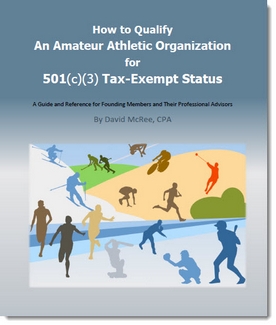How to Get 501c3 Tax-Exempt Status for Your Amateur Athletic Organization
- Booster Clubs
- Little Leagues
- Community Sports Leagues
- Roller Derby
- Sports Training Organizations
- And many others...
So you've decided to form an organization for amateur athletes. Or perhaps you are an amateur athletic organization that has been in existence for a while and has decided to "get into compliance" with IRS rules. Whatever the case, the process is similar.
You'll need to prepare and file IRS Form 1023, Application for Tax Exempt Status. It is a long and complicated form but can be prepared successfully by most anyone willing to invest the time and effort to read the form instructions.
The most important part of the form is the narrative that describes your organization, its purposes and its activities. You have to convince the IRS that the organization actually qualifies for 501(c)(3) status.
You may qualify as an educational organization, or as an organization that promotes national or international sports competition and trains athletes for those competitions. The devil is in the details, as they say.
Fortunately, there is quite a lot of guidance published by the IRS on amateur athletics organizations.
Unfortunately, it can get pretty complicated.
That's where I can help. I've written a guide book and reference that brings all the IRS and Tax Court sources into one handy ebook that distills all the legal gobbledygook into easy-to-read plain English. And I've kept it to fewer than 90 pages.
I've also included in the ebook the descriptive narrative from Form 1023 of a high school booster club that I helped get 501c3 status so you can see exactly how its done. It's almost like having me right there with you giving you guidance. Below is the cover.

Click Here to Purchase the E-Book for Download Now

Click Here to Purchase the E-Book and Download Now
HERE IS THE E-BOOK'S TABLE OF CONTENTS:
Introduction
Important Definitions
Why 501(c)(3)?
Amateur Athletic Organizations: The Big Picture
Characteristics of an Amateur Athletic Organization
The Confounding Problem Confronting the AAO
A Helpful Summary
Qualifying as an Amateur Athletic Organization
Evaluating the Organization
The Educational or Charitable AAO
Defining "Educational" and "Charitable"
IRS Revenue Rulings Useful for Establishing Exempt Status
Organized & Operated Exclusively for Charitable Purposes
Fostering National or International Amateur Sports Competition
The Need for an Amateur Sports Classification
1976: Amateur Athletic Provition
1982: Qualified Amateur Sports Organization Law
Common Problems and Barriers to Tax Exemption
Fundraising Activities of AAOs
Fundraising Profits and Corporate Income Tax
Private Inurement and Private Benefit
Athletic Booster Club Study Cases
Example #1 (This booster would not qualify as a 501c3)
Example #2 (This booster qualifies as a 501c3)
Analysis of Booster Club A and Booster Club B
Scholarships and Allowances to Amateur Athletes
Corporate Sponsorships vs. Advertising Revenue
Advertising Revenue
Qualified Sponsorships
Compensation Paid to Amateur Athletes
Deductibility of Contributions
Fundraising Contributions
Reference Materials
Understanding Internal Revenue Code Citations
Selected Text from the Internal Revenue Code
Section 501(a) Exemption from Taxation
Section 501(c)(3) Charitable Organizations
Section 501(c)(4) Social Welfare Organizations
Section 501(c)(7) Social Clubs
Section 501(j) Qualified Amateur Sports Organization
Treasury Regulations
Treasury Regulation 1.501(c)(3)-1(d)(3) Defining Educational
Using Revenue Rulings to Persuade the IRS
Table of Helpful Revenue Rulings
Text of Revenue Rulings
Court Cases
Example Narrative Statement for IRS Form 1023
Your Articles of Incorporation

Click Here to Purchase the E-Book for Download Now
